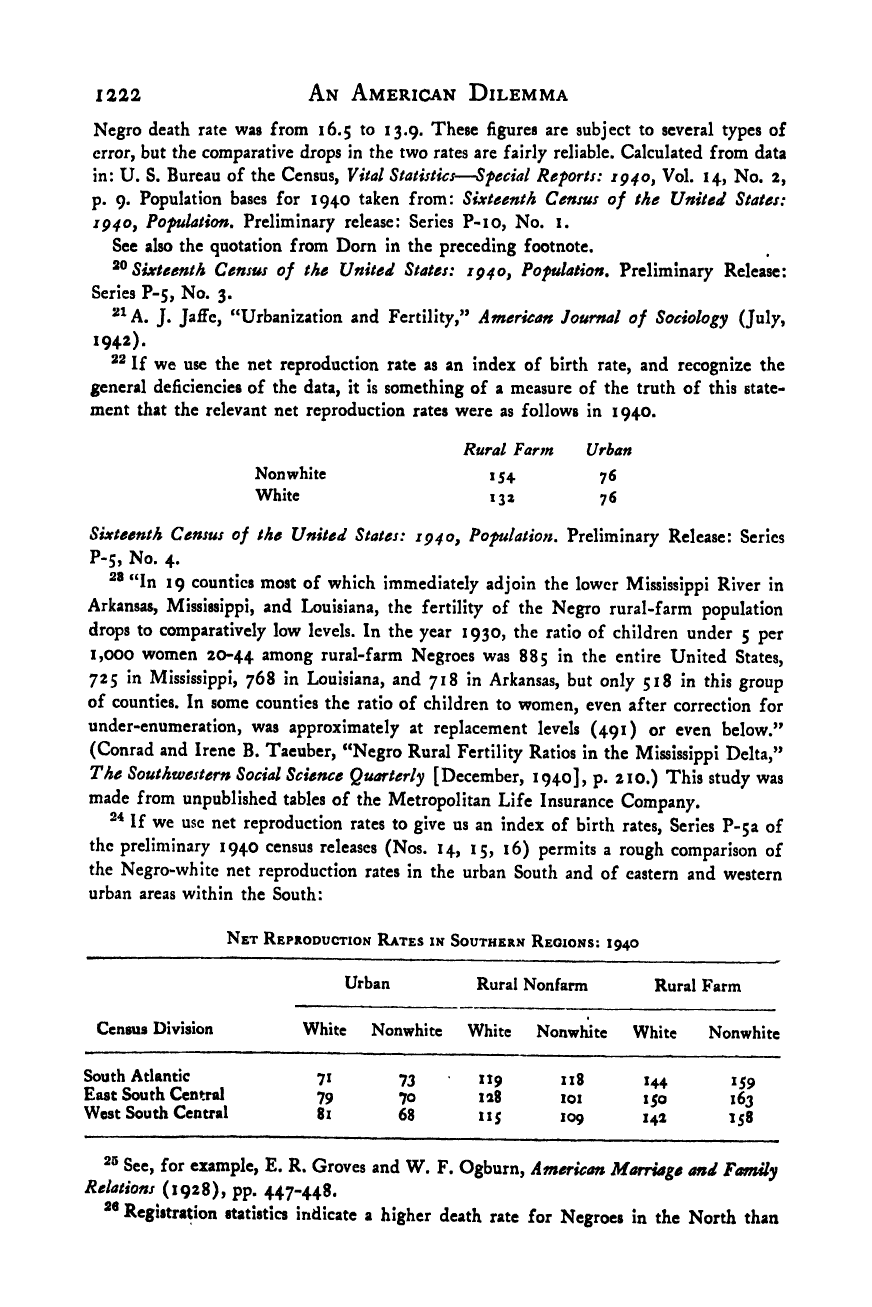Note: Gunnar Myrdal died in 1987, less than 70 years ago. Therefore, this work is protected by copyright, restricting your legal rights to reproduce it. However, you are welcome to view it on screen, as you do now. Read more about copyright.
Full resolution (TIFF) - On this page / på denna sida - Footnotes - Chapter 7

<< prev. page << föreg. sida << >> nästa sida >> next page >>
Below is the raw OCR text
from the above scanned image.
Do you see an error? Proofread the page now!
Här nedan syns maskintolkade texten från faksimilbilden ovan.
Ser du något fel? Korrekturläs sidan nu!
This page has never been proofread. / Denna sida har aldrig korrekturlästs.
1222 An American Dilemma
Negro death rate was from 16.5 to 13.9. These figures are subject to several types of
error, but the comparative drops in the two rates are fairly reliable. Calculated from data
in: U. S. Bureau of the Census, Vital Statistics—Sfecial Reforts: 1^40, Vol. 14, No. 2,
p. 9. Population bases for 1 940 taken from: Sixteenth Census of the United States:
1940^ Pofulation, Preliminary release: Series P-10, No. i.
See also the quotation from Dorn in the preceding footnote.
Sixteenth Census of the United States: 1940^ Pofulation, Preliminary Release:
Series P-5, No. 3.
J. Jaffc, “Urbanization and Fertility,” American Journal of Sociology (July,
1942).
If we use the net reproduction rate as an index of birth rate, and recognize the
general deficiencies of the data, it is something of a measure of the truth of this state-
ment that the relevant net reproduction rates were as follows in 1940.
Rural Farm Urban
Nonwhite 154 76
White 132 76
Sixteenth Census of the United States: 1940^ Pofulation, Preliminary Release: Series
P-5, No. 4.
“In 19 counties most of which immediately adjoin the lower Mississippi River in
Arkansas, Mississippi, and Louisiana, the fertility of the Negro rural-farm population
drops to comparatively low levels. In the year 1930, the ratio of children under 5 per
1,000 women 20-44 among rural-farm Negroes was 885 in the entire United States,
725 in Mississippi, 768 in Louisiana, and 718 in Arkansas, but only 518 in this group
of counties. In some counties the ratio of children to women, even after correction for
under-enumeration, was approximately at replacement levels (491) or even below.”
(Conrad and Irene B. Taeuber, “Negro Rural Fertility Ratios in the Mississippi Delta,”
The Southwestern Social Science Quarterly [December, 1940], p. 210,) This study was
made from unpublished tables of the Metropolitan Life Insurance Company.
If we use net reproduction rates to give us an index of birth rates. Series P-5 a of
the preliminary 1940 census releases (Nos. 14, 15, 16) permits a rough comparison of
the Negro-white net reproduction rates in the urban South and of eastern and western
urban areas within the South:
Net Reproduction Rates in Southern Regions: 1940
Census Division
Urban Rural Nonfarm Rural Farm
White Nonwhite White Nonwhite White Nonwhite
South Atlantic 71 73 119 118 —mm
East South Central 79 70 128 101
West South Central 81 68 ns 109
1
See, for example, E. R. Groves and W. F. Ogburn, American Marriage and Family
Relations (1928), pp. 447-448.
Registration statistics indicate a higher death rate for Negroes in the North than
<< prev. page << föreg. sida << >> nästa sida >> next page >>